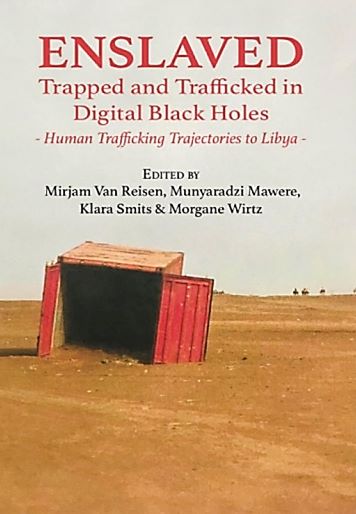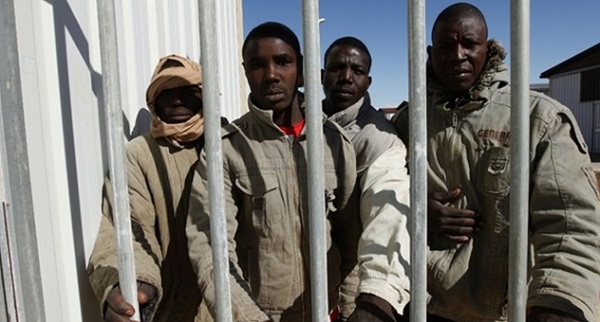|

|
Martin Plaut
Feb 3
|
Source: Africa Ex-Press
[Computer translation from Italian]
Between 2017 and 2021, over 200,000 migrants were brought to Libya and reduced to a total state of slavery.

This is supported by research conducted by Mirjam van Reisen , professor of International Relations at the University of Tilburg (The Netherlands), in collaboration with Munyaradzi Mawere of the University of Unisa, South Africa, as well as holder of the chair of African Studies at the Great Zimbabwe University .
Also participating in the study were Klara Smits , a PhD candidate at Tilburg University, specializing in human trafficking routes from Eritrea to Libya, and Morgane Wirtzè, a PhD candidate at Tilburg University, where she researches human trafficking and sexual violence. in Libya.
In these days the book ENSLAVED has been published. Trapped and Trafficked in Digital Black Holes”: Human Trafficking Trajectoriories to Libya”, which includes the result of the scholars' research.
Many of the refugees who have landed in Libya are Eritreans , they in particular are trafficked and enslaved, subjected to torture, abuse of all kinds and even sexual violence to force family members to pay a ransom for their release.
If they manage to escape from the concentration camps and reach the Mediterranean, they risk being intercepted and sent back to Libya or dying at sea. These are the conclusions of the research, published in the book.

Using ingenious digital methods , such as a tag with an electronic code, human traffickers transport refugees through a series of "black holes", digital voids, as migrants often do not have access to the internet and most are even cut off their cellular.
Thanks to digital technologies , traffickers control the internet access of refugees fleeing their countries, especially from the Eritrean dictatorship.
Many die along the way . During the period of this study (2017-2021), it is estimated that at least 200,000 refugees – men, women and children – were victims of human trafficking for extortion in Libya. It is estimated that the turnover of the shady traffic is around one billion dollars.
In the publication, the researchers argue that inequalities in access and control of digital and connection technologies have contributed to making trafficking possible, reducing hundreds of thousands of human beings into total slavery.
The policies of the European Union , Libya and other countries in the Horn of Africa have also ensured that this state of affairs has persisted over time, indeed according to the researchers it seems that they have even fueled it.
Without legal aid in accordance with international law, Eritreans especially remain trapped in a cycle of human trafficking from which it is difficult, if not impossible, to escape.
The research arose from on-the-spot contact with refugees , who managed to send secret recordings or communicate via social media. Most of the interviews with refugees who have managed to flee took place in countries bordering Libya, such as Niger, Sudan and Tunisia. Refugees who managed to reach Europe were also heard directly .
This detailed ethnographic study identifies the routes , modus operandi, organization and key actors involved in human trafficking for the purpose of ransom refugees and migrants.
The book is part of the GAIC research network (Tilburg University) and the African studies series published by Langaa RPCIG and provides an important contribution to the literature on human trafficking, migration studies, African populations, modern slavery, social protection and governance.
Earlier this year , Eritrean Kidane Zekarias Habtemariam, one of the most vicious traffickers of human beings, was arrested in Sudan . His arrest was possible thanks to the contribution of the United Arab Emirates and Interpol.
The trafficker was placed on the Dutch Most Wanted list.
Thanks to its capillary network , which extended from Somalia to Libya, it organized the trafficking of thousands of Ethiopian, Eritrean and Somali youths to Europe, through Libya. Kidane has put aspiring asylum seekers through hell with torture, violence, to extort money from family members.
Kidane was recognized on the streets of Addis Ababa by a migrant, tortured by himself. The criminal was then arrested for the first time in Ethiopia in 2020. Tried for human trafficking, a year later he managed to escape from the federal court in the Ethiopian capital. Thanks to the complicity of police officers, he changed in the courthouse toilets before leaving the building incognito. Months later, Ethiopia sentenced him in absentia to life imprisonment.
In the last two years , before his new arrest in Sudan, he continued his shady dealings undisturbed. The Netherlands has asked Khartoum for his extradition for trafficking in human beings between Africa and Europe.
|
 increase font size
increase font size


